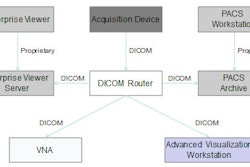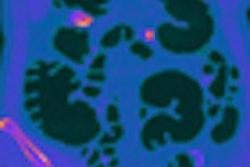If in-house IT support is available, open-source PACS software and virtual computing technology may offer a reasonable option for digital image management for some institutions, according to researchers from the University of Patras in Rion, Greece.
In an article published online in the Journal of Digital Imaging, a research team led by George Kagadis, PhD, found that open-source image management could be reliable and well-received by end users when deployed in support of a digital subtraction angiography (DSA) unit.
Virtual machines
A number of open-source PACS software packages are available today and have drawn interest from small healthcare organizations or cash-strapped enterprises. In addition, another technology trend, virtual computing, can allow a single computer to host multiple "virtual machines" as if they were installed on separate physical computers, according to the researchers. This also enables PACS built on virtual machines to be moved to more powerful computers as necessary, according to the researchers (J Digit Imaging, July 12, 2011).
After reviewing a number of open-source PACS software candidates for its DSA unit, the team settled on the ClearCanvas Image Server. They elected to also employ the free VMware virtualization software to help minimize installation and maintenance costs, as well as development time.
For hardware, the group purchased a PC with a 2.8-GHz Intel Xeon Processor, an Intel RAID controller, and 8 GB of RAM. Six 1-TB hard drives were acquired and installed in two RAID 10 arrays.
The PACS was installed in November 2010 and has worked continuously without problems, according to the researchers. Physicians can read images on 20 attached workstations, and the PACS has been well-received by all medical personnel.
"The whole installation was easy to perform, and the resultant PACS is very reliable in its everyday use in a university hospital," they wrote.
After each study is completed, it is sent to the PACS server; transfer time varies from two to five minutes.
To gauge end-user satisfaction, the researchers surveyed 20 radiologists and residents of the DSA unit. Using a scale of 1 (strongly disagree) to 5 (strongly agree), they were asked whether the PACS was an improvement, whether the PACS performance is acceptable, whether the PACS image tools are acceptable, and whether the PACS implementation improved diagnostic process.
Median scores:
- PACS is an improvement over the old workflow (4)
- PACS performance is acceptable (5)
- PACS image tools are acceptable (3)
- PACS implementation improved diagnostic process (4)
"These results are quite satisfactory despite the fact that the median answer to question Q3 is 3 (neutral)," the authors wrote. "We believe that the users will familiarize themselves better with the proposed solution in the future as they work with this implementation."
In deciding whether this approach is right for them, institutions must first address the question of whether open-source PACS is a viable option, then consider when to use virtualization, Kagadis told AuntMinnie.com.
"The former question raises support concerns if you don't have in-house IT help," he said. "The latter raises performance issues. There is no absolute answer for either; a site will have to balance their needs and budget."
Open-source PACS software is now competitive compared with commercially available products and doesn't require special IT skills, Kagadis said. Open-source software also includes documentation and support advice. The main disadvantage, though, is that the provided support may be insufficient to meet some institutions' needs.
"Also, many of the open-source projects don't continue the 'production' forever; some of them are aborted by their developers, or in a good case they are changed to commercial [products]," Kagadis said. "Nevertheless, the selection of a widely accepted open-source [software] can operate in an organization for many years."
If money isn't an issue or if in-house IT support is unavailable, commercial PACS may still be the best option, he said.
"[But] if you are on a budget, have a modicum of IT knowledge, and respect the need [for] reliability and data safety, try a [free open-source software] approach," Kagadis said. "The worse that could happen is turning the hardware you bought over to a vendor if you fail."
The researchers also noted that institutions need to be aware of some regulatory issues when using open-source software.
"For instance, in the USA, the FDA [Food and Drug Administration] regulates vendors who sell devices that provide medical care," they wrote. "In the case of freely distributed open-source software, though, the FDA has taken the position that the user assumes all liability [since the source code is available to see]. On the other side of the Atlantic, use of open-source software in healthcare has been considered [a] key solution in European Union countries."



















